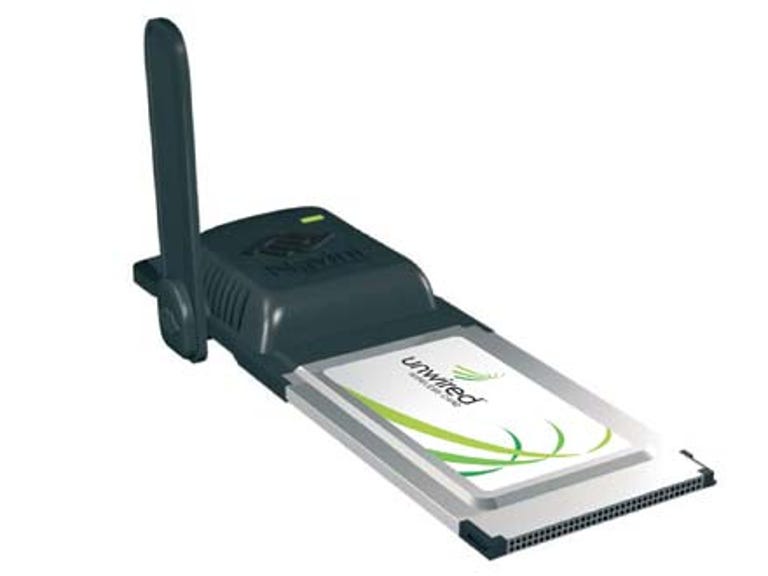 Why You Can Trust CNET
Why You Can Trust CNET Unwired Wireless Card review: Unwired Wireless Card
While the speed and pricing plans make it appealing for those who aren't deskbound, Unwired's Wireless Card is cruelled by the lack of true mobility and the Sydney-only coverage, which itself is undeniably patchy.
Unwired's long-awaited notebook card cuts the cables to the wireless ISP's bookend-sized desktop modems and enters the crowded 'Internet on the move' fray dominated by 3G carriers.
The Good
The Bad
The Bottom Line
However, instead of usurping mobile phone networks, Unwired relies on a dedicated slab of microwave frequencies and a spread of around 80 transmitter towers dotting the Sydney landscape to provide true ADSL-grade broadband at up to 750Kbps - roughly twice the peak throughput of 3G.
While it's not WiMax, this is as close as we'll get until that broadband wireless service makes a local debut in mid-late 2006 (Unwired is in pole position thanks to its canny licensing of WiMax frequencies, a WiMax-ready backend and AU$37 million in funding from Intel.)
Design
This hump poses an immediate usability issue for anyone who doesn't type with their hands poised fully over the keyboard. More 'casual' typists (this writer among them) will find one of their hands constantly bumping against the hump and its stubby antenna. Testing the card on a range of notebooks showed that larger laptops with more wrist-rest area made for less awkward typing, depending on the location of the PC Card slot, but on a 12in subnotebook the left hand ends up bent at such an angle that the whole solution becomes almost unusable.
Another hitch for super-slim subnotes is that the bottom of the aerial protrudes a half centimetre below the card itself. With the PC Card slot already sitting at close to ground zero, the notebook can end up resting on the card's antenna stub instead of sitting flush on its own rubber feet. However, we discovered that in strong signal areas you could remove the external antenna without affecting the card's performance.
At least Unwired has kept the mobile-minded customer in mind by supplying a sturdy plastic clamshell case for protecting the card and antenna when not in use.
Features
As Windows XP treats the Unwired card as just another wireless network connection, the client 'launchpad' software can be mostly ignored - as can Unwired's clunky Webmail client interface, which can fortunately be set up as a POP3 account in your regular email software so you'll be spared dealing with its sluggish speed and Spartan interface. Unwired also blots its copybook by hijacking your Web browser's home page setting to point to Unwired's site.
Unfortunately, without Macintosh drivers or setup software, Apple users are left out in the cold.
Unwired offers four access plans, although none of them defray the card's upfront AU$299 cost. The entry level 'Breakaway 400' plan kicks in at AU$49.95 per month for a connection at up to 512Kbps (with 128Kbps upstream) and 400MB of downloads. AU$69.95 steps you up to 750Kpbs and 2GB of downloads; AU$89.95 triples the download cap to 6GB and doubles the uplink speed to 256Kbps, while the premium AU$109.95 scheme allows for 12GB of downloads per month.
Excess downloads see the account throttled back to 64Kbps rather than slug the user with an additional per-megabyte fee; similarly, the uplink wick is wound back to a mere 32Kbps. Each plan is on a 12 month contract and customers can switch between plans without cost.
In terms of speed and download limits, these plans stack up well against those available from 3G carriers, although less so against the multitude of plans served by resellers of Unwired's competitor iBurst.
 Unwired coverage map (click for larger image) |
Where Unwired loses out is that its network is currently limited to the greater Sydney area, which can't match the more expansive sweep of iBurst or any of the mobile phone carriers.
Performance
We suggest potential customers take advantage of this trial period to test performance at their most commonly-visited locations, especially when it comes to the actual connection speed: there's no use signing up for a 750Kbps plan if the best you can get is 500Kbps, although of course the download limits of each plan need to be taken into account.
We clocked a reliable average of 700Kbps around locations in North Sydney, the CBD and the eastern suburbs. In most instances the signal was strong enough that we could remove the card's antenna with no impact on throughput. Where the external 12cm antenna with its portable base and 50cm cable came to the fore was in boosting reception deep inside a building, as the microwave bands used by Unwired have trouble punching through walls.
The mid-range latency (just shy of 400ms) is adequate for remote access sessions, although we found VoIP performance patchy.
As expected, this isn't a truly 'mobile' solution - it's more about giving you a portable notebook-friendly alternative to Unwired's larger and more unwieldy desktop modem. Once you're actually on the move, the connections are best described as sporadic, and without any smooth handover from cell to cell, you'll be driven mad by the constant dropout and reconnection routine.
You'll also want to consider never leaving home without your notebook's power adaptor, as the Unwired card consumed an average 25% off the battery life of our test laptops (which ranged from a slim ThinkPad X31 to a mid-range Toshiba Satellite M50).
There's no avoiding the caveats that accompany Unwired's Wireless Card. While the speed and pricing plans make it appealing for those who aren't deskbound, it's cruelled by the lack of true mobility and the Sydney-only coverage, which it itself is undeniably patchy. Many road warriors will find these to be fatal flaws that steer them towards alternatives such as iBurst or a 3G data card.

